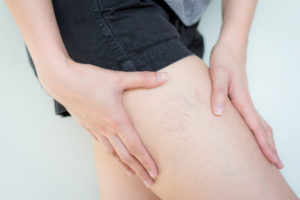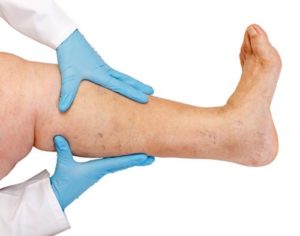CVD (Chronic venous disease, also known as chronic venous insufficiency) refers to several vein problems. And all of those problems are chronic. But what does that mean for you? If you have CVD, you may develop varicose veins,
spider veins, and/or
ulcers on your lower legs.
Now, that's what can happen with venous disease. But, why does CVD occur? Well, the condition develops when the veins in your legs can't return blood to your central circulatory system or heart. Ignore the problem, and CVD will get worse. Which could mean pain, damage to your legs, and other medical issues such as blood clots. That's why it's important to know the risk factors and warning signs of CVD. So you can receive a diagnosis and treatment plan before you face serious complications.

What is My Risk Factor for Chronic Venous Disease (CVD)?
Unfortunately, just getting older puts you at higher risk for CVD. As your body ages, the valves in your vein face more stress. And that can prevent your blood from flowing out of your feet and legs, back to your heart.
Gender is another risk factor. Because women get CVD more frequently than men. Why is that the case? Things like hormone replacement therapy, and hormonal birth control can increase your risk. And so can pregnancy, because it adds to hormonal changes and physical stress. Finally, genetics are a risk factor. People with a family history of
varicose veins, deep vein thrombosis (DVT) or other vascular diseases are more likely to develop CVD.
New Data on Diabetes and CVD
In a recent study, researchers discovered a link between diabetes, muscle mass, grip strength and CVD risk. The data suggest that, at least for diabetic patients, having low muscle mass and a weak grip was associated with a stronger risk for CVD,
PAD and even coronary heart disease.
In other words, working on your physical strength can help protect you from vascular problems. And that makes sense, since we know that how you live also makes a difference for your vein health. If you're obese, sedentary or spend lots of time of standing or sitting, you put pressure on your veins. Then, if you add in insufficient physical activity, you'll really up your risk for CVD. If any of that sounds familiar, now's a good time to get exercising. Because staying active will
help improve your circulation and keep your body better supplied with oxygen.
What are the Symptoms of CVD?
If you experience any of the following symptoms or have chronic or debilitating leg pain,
it is best to seek evaluation and discuss treatment options with a medical professional as soon as possible. Left untreated, these symptoms could worsen, causing more pain or even more serious medical conditions.
- Leg aches and pains
- Leg cramping and night gramps
- Tired or heavy legs
- Restless legs
- Rashes, skin darkening, or patches of dry itchy skin on the leg
- Burning or itching veins in lower extremities
- Ulcers on the leg that are slow to heal
- Restless legs
- Blue, bulging twisted veins (varicose veins or spider veins)
- Recurrent cellulitis
- Swollen or tight-feeling ankles
- Lymphedema (a build-up of fluid underneath the skin)
- Spontaneous bleeding
Texas Endovascular provides several treatment options for patients with chronic venous disease. Contact us to schedule a consultation if you are experiencing any of the above symptoms.
Treatment Options for Chronic Venous Disease 
Early detection and treatment can decrease the pain of CVD and reduce the risk of developing additional, more serious medical complications.
Detection and diagnosis of chronic venous disease, as well as arterial disease and blood clots, is done with a diagnostic ultrasound evaluation. This technology enables a sonographer to see inside the body and locate both superficial and deep varicose veins.
We offer wide variety of treatment options for chronic venous disease, including:
Radiofrequency ablation (RFA)
RFA involves inserting a catheter into the abnormal vein and using heat energy to close it. The procedure takes less than an hour, requires only a local anesthetic and leaves no scar.
Ultrasound guided foam sclerotherapy
We often use ultrasound guided sclerotherapy to close any residual, non-bulging varicose veins after radiofrequency ablation. The procedure uses ultrasound to access a vein. Using a small needle, a medication combined with carbon dioxide gas is injected into the abnormal vein to close it. The procedure is quick, and patients are able to resume their daily activities immediately afterward. Anti-inflammatory medications and compression stockings may be used to help manage any discomfort following RFA and ultrasound sclerotherapy.
Our additional treatment options for eliminating bulging and spider veins caused by CVD include:
- Cosmetic sclerotherapy
- Radiofrequency perforator ablation
- Ambulatory phlebectomy
Varicose Vein Help in Texas
Dr. William C. Fox and Dr. Eric Hardee of Texas Endovascular specialize in treating patients with chronic venous disease using state-of-the-art technology and minimally invasive procedures. The results provide quick relief from the symptoms of CVD, and patients are typically able to resume their normal, day-to-day activities immediately following treatment.
If you are experiencing symptoms of CVD, don’t wait to seek treatment. Contact our expert physicians today to
schedule a consultationschedule a consultationschedule a consultation.
Source Page: https://texaseva.com/sources/


